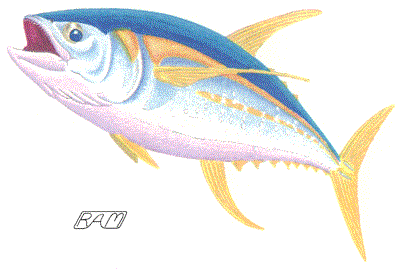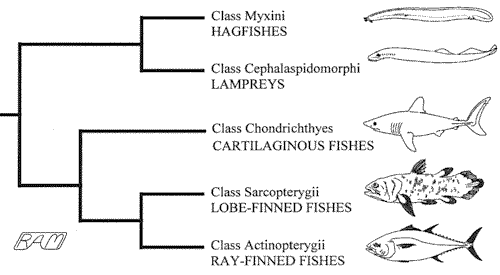Fishes: a Slippery Subject
 By any account, fishes are extraordinarily successful creatures. They have
successfully colonized virtually every wet habitat on our planet. From the
deepest ocean trench to the highest alpine lake, if there's permanent water
you'll more than likely find fishes - often in astonishing numbers. At more than
24 000 species, fishes are incredibly diverse, representing an amazing variety
of forms and lifestyles. So where does one begin to classify them?
By any account, fishes are extraordinarily successful creatures. They have
successfully colonized virtually every wet habitat on our planet. From the
deepest ocean trench to the highest alpine lake, if there's permanent water
you'll more than likely find fishes - often in astonishing numbers. At more than
24 000 species, fishes are incredibly diverse, representing an amazing variety
of forms and lifestyles. So where does one begin to classify them?
Most people are confident that they have a pretty good idea of what a fish is. But recognizing fishiness is not as simple or as straight-forward as many might suppose. This is because many fishes lack what are usually thought of as 'fishy' characteristics. Characteristics like fins, scales, cold-bloodedness, water-breathing, and even eyes are not shared by all fishes. Some eels lack fins. Lampreys and some freshwater catfishes are completely scaleless, while paddlefishes, some sticklebacks and sculpins are nearly so. Tunas and some sharks are functionally warm-blooded. Mudskippers actually drown if held underwater. Hagfishes and blind cave fish lack eyes. In general, however, most fishes have fins and scales, are cold-blooded, breathe water via gills, and have eyes, but it is surprisingly difficult to list characteristics common to all forms.
All known fishes are multicellular organisms that do not manufacture their own food. Therefore they - along with ourselves and many other creatures - are members of the kingdom Animalia. All fishes have a notochord (stiff cartilaginous rod extending along the back), a tubular nerve chord just above it, gill pouches in the throat region, segmental muscle blocks, and a tail posterior to the anus or cloaca. As such, they - along with less familiar creatures such as tunicates, acorn worms, and lancelets - are card-carrying members of the phylum Chordata. All fishes have a backbone divided into segmental vertebrae (even those that lack bones), and are therefore members of the sub-phylum Vertebrata. Vertebrates include many of the most familiar animals: amphibians, reptiles, birds, and mammals (including dogs, cats, horses, elephants, whales, apes, and us). Such non-fishy vertebrates are termed 'tetrapods' - which means "four-footed", in reference to the fact that all have two sets of paired limbs.
Extant fishes are currently divided into five distinct classes: Myxini (hagfishes), Cephalaspidomorphi (lampreys), Chondrichthyes (cartilaginous fishes), Sarcopterygii (lobe-finned fishes), and Actinopterygii (ray-finned fishes.) The accompanying cladogram shows how these classes of living fishes are believed to be interrelated. All sharks and rays belong to the class Chondrichthyes. Most familiar bony fishes - including sturgeons, gars, eels, herrings, carps, catfishes, salmons, mullets, perches, pipefishes, scorpionfishes, butterflyfishes, gobies, tunas, billfishes, flatfishes, pufferfishes, and many, many others - are placed in the class Actinopterygii. But it is the class Sarcopterygii to which I would like to draw your attention.

Sometimes referred to as 'sarcops', the class Sarcopterygii includes 'primitive' fishes such as the lungfishes (represented in each of the southern continents by a separate family) and the Coelacanth (Latimeria chalumnae), a long-lost survivor from the Age of Dinosaurs living in deep waters off southeastern Africa and Indonesia. The sarcops are most notably characterized by having jaws with fixed teeth, a bony skeleton, a skull with sutures, a type of scale known as '"cosmoid", and heavy, lobe-like paired fins (pectoral and pelvic) supported by stout bones. For this reason, sarcops are informally known as the lobe-finned fishes. As their name suggests, lungfishes actually have primitive lungs and breathe not water, but air.
Consider that the tetrapods, too, have jaws with fixed teeth, a bony skeleton, a skull with sutures, and heavy, paired appendages. As we have seen, scales are not at all a defining character of fishiness, nor is breathing by way of gills. Therefore, based on many structural and physiological synapomorphies, the tetrapods not only share a common ancestor with the lobe-finned fishes, but are derived from them. The tetrapods are now generally believed to represent a subclass within the Sarcopterygii. And therein lies a major reason for the difficulties in defining fishes as a group. Fish - as the term is usually applied - is not a monophyletic taxon.
If we are to include the common ancestor of the fish-like vertebrates and all of its descendants, then we must include the tetrapods. Thus, frogs, snakes, ducks, kangaroos, elephants, rats, bats, whales, and other mammals, are all sarcopterygian 'fishes'. To put this another, more cogent way: cladistically speaking, we are fish.
